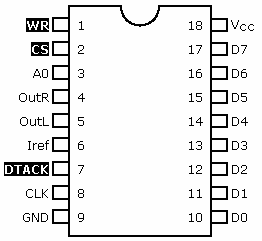Philips SAA1099
The Philips SAA1099 sound generator is a 6-voice sound chip used by some 1980s devices. It can produce several different waveforms by locking the volume envelope generator to the frequency generator, and also has a noise generator with 3 pre-set frequencies which can be locked to the frequency generator for greater range. It can output audio in fully independent stereo.
| Philips SAA1099 | |||
|---|---|---|---|
 | |||
| Pin | Name | Dir | Description |
| 1 | /WR | Write Enable | |
| 2 | /CS | Chip Select | |
| 3 | A0 | Control/Address Selec | |
| 4 | OUTR | Sound Output Right | |
| 5 | OUTL | Sound Output Left | |
| 6 | IREF | Reference Current Supply | |
| 7 | /DTACK | Data Transfer Acknowledge | |
| 8 | CLK | External Clock | |
| 9 | VSS | Ground | |
| 10 | D0 | Data Bus 0 | |
| 11 | D1 | Data Bus 1 | |
| 12 | D2 | Data Bus 2 | |
| 13 | D3 | Data Bus 3 | |
| 14 | D4 | Data Bus 4 | |
| 15 | D5 | Data Bus 5 | |
| 16 | D6 | Data Bus 6 | |
| 17 | D7 | Data Bus 7 | |
| 18 | VDD | Power +5V | |
Uses
- The British-made SAM Coupé computer
- The Creative Music System (C/MS) by Creative Labs, which was also marketed at RadioShack as the Game Blaster. They had 2 chips, for 12 voices.
- The Creative Sound Blaster 1.0 card (also 1.5 and 2.0 as an optional addon). Thse cards also had an OPL2 chip (aka YM3812), which became much more popular.
- Silicon Graphics used it on the IO2 and IO3 board for sound generation. Although this feature was almost never documented or used, the SAA1099 is present and usable if addressed directly.
gollark: EVERY LANGUAGE HAS TO USE LIBRARIES!
gollark: FOOL!
gollark: Rust's got libraries for that, yo.
gollark: Besides, you can implement them without the language having HOFs.
gollark: Not really.
External links
This article is issued from Wikipedia. The text is licensed under Creative Commons - Attribution - Sharealike. Additional terms may apply for the media files.